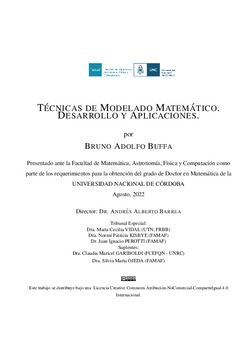| dc.contributor.advisor | Barrea, Andrés Alberto | |
| dc.contributor.author | Buffa, Bruno Adolfo | |
| dc.date.accessioned | 2022-10-24T12:58:44Z | |
| dc.date.available | 2022-10-24T12:58:44Z | |
| dc.date.issued | 2022-08 | |
| dc.identifier.uri | http://hdl.handle.net/11086/29110 | |
| dc.description | Tesis (Doctor en Matemática)--Universidad Nacional de Córdoba, Facultad de Matemática, Astronomía, Física y Computación, 2022. | es |
| dc.description.abstract | Los modelos matemáticos se utilizan para el estudio, análisis y comprensión
de diferentes fenómenos abordados por las ciencias exactas y de la salud, como
ası́ también en ciencias sociales. Un modelo puede ser definido como la representación de algún sistema real o abstracto que tiene por fin último resolver un
problema o responder cierta pregunta relacionada a ese sistema. En términos generales, el objetivo del proceso de modelado es entender el funcionamiento, explicar
patrones observados y predecir el comportamiento frente a eventuales cambios
en el sistema estudiado. Tradicionalmente, el enfoque estándar para el modelado matemático se apoyó en modelos basados en ecuaciones diferenciales, pero
sin embargo en la literatura de los últimos años se destaca la implementación de
nuevas perspectivas. Este trabajo se orienta al estudio de distintos tipos de modelización a través de herramientas matemáticas que se apartan de los cánones
usuales de modelado, para lo cual se presentan tres enfoques de modelización no
convencionales. | es |
| dc.description.abstract | Mathematical models are used for the study, analysis and understanding of different phenomena in the exact and health sciences, as well as in the social sciences. A model can be defined as the representation of some real or abstract system whose ultimate purpose is to solve a problem or answer a certain question related to that system. In general terms, the objective of the modeling process is to understand the functioning, explain observed patterns and predict behavior in the face of eventual changes in the system under study. Traditionally, the standard approach to mathematical modeling has relied on models based on differential equations, but in the literature of recent years, the implementation of new perspectives has been highlighted. This work is oriented to the study of different types of modeling through mathematical tools that depart from the usual modeling canons, for which three non-conventional modelling approaches are presented. | en |
| dc.language.iso | spa | es |
| dc.rights | Atribución-NoComercial-CompartirIgual 4.0 Internacional | * |
| dc.rights.uri | http://creativecommons.org/licenses/by-nc-sa/4.0/ | * |
| dc.subject | Modelos de agentes heterogéneos | es |
| dc.subject | Modelización matemática | es |
| dc.subject | Teoría cinética de partículas activas | es |
| dc.subject | Modelos computacionales | es |
| dc.subject | Optimización y control | es |
| dc.subject | Heterogeneous agent models | es |
| dc.subject | Mathematical modeling | en |
| dc.subject | Agent-based models | en |
| dc.subject | Kinetic theory of active particles | en |
| dc.subject | Computational models | en |
| dc.subject | Optimization and control | en |
| dc.title | Técnicas de modelado matemático. Desarrollo y aplicaciones | es |
| dc.type | doctoralThesis | es |
| dc.description.fil | Fil: Buffa, Bruno Adolfo. Universidad Nacional de Córdoba. Facultad de Matemática, Astronomía, Física y Computación; Argentina. | es |





